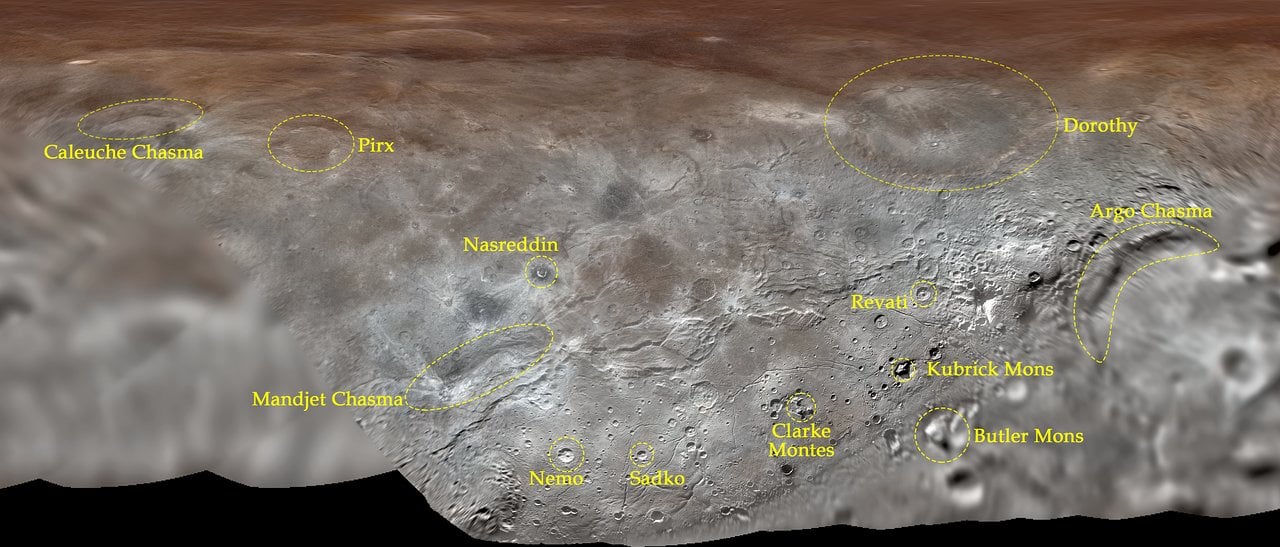In 2015, the
*New Horizons*
mission made history by being the first spacecraft to conduct a
flyby of Pluto
. In addition to revealing things about the planet's atmosphere, its geology and system of moons, the probe also provided the first clear images of the surface of Pluto and its largest moon, Charon. Because of this, scientists are now able to study Pluto and Charon's many curious surface features and learn more about their evolution.
Another interesting thing that has resulted from this surface imaging has been the ability to name these features. Recently, the
IAU Working Group for Planetary System Nomenclature
officially approved
of a dozen names that had been proposed by NASA's
New Horizons
team. These names honor legendary explorers and visionaries, both real and fictitious, and include science fiction authors Octavia Butler and Arthur C. Clarke.
Aside from being Pluto's largest moon, Charon is also one of the larger bodies in the Kuiper Belt. Because of its immense size, Charon does not orbit Pluto in the strictest sense. In truth, the barycenter of the Pluto-Charon system is outside Pluto, meaning the two bodies almost orbit each other. The moon also has a wealth of features, which include valleys, crevices, and craters similar to what have been seen on other moons.
[caption id="attachment_134988" align="aligncenter" width="468"]
Artist's impression of New Horizons' close encounter with the Pluto–Charon system. Credit: NASA/JHU APL/SwRI/Steve Gribben
[/caption]
For some time, the
New Horizons
team has been using a series of informal names to describe Charon's many features. The team gathered most of them during the online public naming campaign they hosted in 2015. Known as "
Our Pluto
", this campaign consisted of people from all over the world contributed their suggestions for naming features on Pluto and Charon.
The
New Horizons
team also contributed their own suggestions and (according to the IAU) was instrumental in moving the new names through approval. As Dr. Alan Stern, the New Horizon team leader, told Universe Today via email: "We conduced a public feature name bank process in 2015 before flyby. Once flyby was complete our science team created a naming proposal for specific features and sent it to IAU."
A similar process took place
last year
, where the IAU officially adopted 14 place names that were suggested by the
New Horizons
team - many of which were the result of the online naming campaign. Here too, the names were those that the team had been using informally to describe the many regions, mountain ranges, plains, valleys and craters that were discovered during the spacecraft's flyby.
The names that were ultimately selected honored the spirit of epic exploration, which the
New Horizons
mission demonstrated by being the first probe to reach Pluto. As such, the names that were adopted honored travelers, explorers, scientists, pioneering journeys, and mysterious destinations. For example, Butler Mons honors Octavia E. Butler, a celebrated author and the first science fiction writer to win a MacArthur fellowship.
[caption id="attachment_121694" align="aligncenter" width="580"]
Global map of Pluto's moon Charon pieced together from images taken at different resolutions. Credit: NASA/Johns Hopkins University Applied Physics Laboratory/Southwest Research Institute
[/caption]
Similarly, Clarke Montes honors Sir Arthur C. Clarke, the prolific writer and futurist who co-wrote the screenplay for 2001: A Space Odyssey* (which he later turned into a series of novels). Stanley Kubrik, who produced and directed 2001: A Space Odyssey,* was also honored with the feature Kubrik Mons. Meanwhile, several craters were named in honor of fictional characters from famous stories and folklore.
The Revati Crater is named after the main character in the Hindu epic narrative Mahabharata while the Nasreddin Crater is named for the protagonist in thousands of folktales told throughout the Middle East, southern Europe and parts of Asia. Nemo Crater honors the captain of the Nautilus in Jule's Verne's novels Twenty Thousand Leagues Under the Sea* (1870) and The Mysterious Island* (1874).
The Pirx Crater is name after the main character in a series of short stories by Polish sci-fi author Stanislaw Lem, while the Dorothy Crater takes its name from the protagonist in *The Wizard of Oz*, one of several children's stories by L. Frank Baum that was set in this magical land.
As Rita Schulz, chair of the IAU Working Group for Planetary System Nomenclature, commented, "I am pleased that the features on Charon have been named with international spirit." Dr. Alan Stern expressed similar sentiments. When asked if he was happy with the new names that have been approved, he said simply, "Very."
[caption id="attachment_138825" align="aligncenter" width="580"]
Artist's impression of NASA's New Horizons spacecraft encountering 2014 MU69 (Ultima Thule), a Kuiper Belt object that orbits 1.6 billion km (1 billion mi) beyond Pluto, on Jan. 1st, 2019. Credits: NASA/JHUAPL/SwRI/Steve Gribben
[/caption]
Even though the encounter with the Pluto system happened almost three years ago, scientists are still busy studying all the information gathered during the historic flyby. In addition, the *New Horizons* spacecraft will be making history again in the not-too-distant future. At present, the spacecraft is making its way farther into the outer Solar System with the intention of rendezvousing with two Kuiper Belt Objects.
On Jan. 1st, 2019, it will rendezvous with its first destination, the KBO known as 2014 MU69 (aka. " Ultima Thule "). This object will be the most primitive object ever observed by a spacecraft, and the encounter will the farthest ever achieved in space exploration. Before this intrepid exploration mission is complete, we can expect that a lot more of the outer Solar System will be mapped and named.
Further Reading: IAU
 Universe Today
Universe Today
